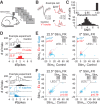Contribution of Sensory Encoding to Measured Bias
- PMID: 31015339
- PMCID: PMC6595953
- DOI: 10.1523/JNEUROSCI.0076-19.2019
Contribution of Sensory Encoding to Measured Bias
Abstract
Signal detection theory (SDT) is a widely used theoretical framework that describes how variable sensory signals are integrated with a decision criterion to support perceptual decision-making. SDT provides two key measurements: sensitivity (d') and bias (c), which reflect the separability of decision variable distributions (signal and noise) and the position of the decision criterion relative to optimal, respectively. Although changes in the subject's decision criterion can be reflected in changes in bias, decision criterion placement is not the sole contributor to measured bias. Indeed, neuronal representations of bias have been observed in sensory areas, suggesting that some changes in bias are because of effects on sensory encoding. To directly test whether the sensory encoding process can influence bias, we optogenetically manipulated neuronal excitability in primary visual cortex (V1) in mice of both sexes during either an orientation discrimination or a contrast detection task. Increasing excitability in V1 significantly decreased behavioral bias, whereas decreasing excitability had the opposite effect. To determine whether this change in bias is consistent with effects on sensory encoding, we made extracellular recordings from V1 neurons in passively viewing mice. Indeed, we found that optogenetic manipulation of excitability shifted the neuronal bias in the same direction as the behavioral bias. Moreover, manipulating the quality of V1 encoding by changing stimulus contrast or interstimulus interval also resulted in consistent changes in both behavioral and neuronal bias. Thus, changes in sensory encoding are sufficient to drive changes in bias measured using SDT.SIGNIFICANCE STATEMENT Perceptual decision-making involves sensory integration followed by application of a cognitive criterion. Using signal detection theory, one can extract features of the underlying decision variables and rule: sensitivity (d') and bias (c). Because bias is measured as the difference between the optimal and actual criterion, it is sensitive to both the sensory encoding processes and the placement of the decision criterion. Here, we use behavioral and electrophysiological approaches to demonstrate that measures of bias depend on sensory processes. Optogenetic manipulations of V1 in mice bidirectionally affect both behavioral and neuronal measures of bias with little effect on sensitivity. Thus, changes in sensory encoding influence bias, and the absence of changes in sensitivity do not preclude changes in sensory encoding.
Keywords: contrast; mouse visual cortex; optogenetics; orientation; psychophysics; signal detection theory.
Copyright © 2019 the authors.
Figures







Similar articles
-
Neuronal Adaptation Reveals a Suboptimal Decoding of Orientation Tuned Populations in the Mouse Visual Cortex.J Neurosci. 2019 May 15;39(20):3867-3881. doi: 10.1523/JNEUROSCI.3172-18.2019. Epub 2019 Mar 4. J Neurosci. 2019. PMID: 30833509 Free PMC article.
-
Mouse Higher Visual Areas Provide Both Distributed and Specialized Contributions to Visually Guided Behaviors.Curr Biol. 2020 Dec 7;30(23):4682-4692.e7. doi: 10.1016/j.cub.2020.09.015. Epub 2020 Oct 8. Curr Biol. 2020. PMID: 33035487 Free PMC article.
-
Perceptual Weighting of V1 Spikes Revealed by Optogenetic White Noise Stimulation.J Neurosci. 2022 Apr 13;42(15):3122-3132. doi: 10.1523/JNEUROSCI.1736-21.2022. Epub 2022 Mar 1. J Neurosci. 2022. PMID: 35232760 Free PMC article.
-
Visual Perceptual Learning and Models.Annu Rev Vis Sci. 2017 Sep 15;3:343-363. doi: 10.1146/annurev-vision-102016-061249. Epub 2017 Jul 19. Annu Rev Vis Sci. 2017. PMID: 28723311 Free PMC article. Review.
-
Statistical decision theory to relate neurons to behavior in the study of covert visual attention.Vision Res. 2009 Jun;49(10):1097-128. doi: 10.1016/j.visres.2008.12.008. Epub 2009 Jan 10. Vision Res. 2009. PMID: 19138699 Review.
Cited by
-
Neuronal Adaptation Reveals a Suboptimal Decoding of Orientation Tuned Populations in the Mouse Visual Cortex.J Neurosci. 2019 May 15;39(20):3867-3881. doi: 10.1523/JNEUROSCI.3172-18.2019. Epub 2019 Mar 4. J Neurosci. 2019. PMID: 30833509 Free PMC article.
-
Effects of Altered Excitation-Inhibition Balance on Decision Making in a Cortical Circuit Model.J Neurosci. 2022 Feb 9;42(6):1035-1053. doi: 10.1523/JNEUROSCI.1371-20.2021. Epub 2021 Dec 9. J Neurosci. 2022. PMID: 34887320 Free PMC article.
-
Mice Preferentially Use Increases in Cerebral Cortex Spiking to Detect Changes in Visual Stimuli.J Neurosci. 2020 Oct 7;40(41):7902-7920. doi: 10.1523/JNEUROSCI.1124-20.2020. Epub 2020 Sep 11. J Neurosci. 2020. PMID: 32917791 Free PMC article.
-
All-optical recreation of naturalistic neural activity with a multifunctional transgenic reporter mouse.Cell Rep. 2023 Aug 29;42(8):112909. doi: 10.1016/j.celrep.2023.112909. Epub 2023 Aug 4. Cell Rep. 2023. PMID: 37542722 Free PMC article.
-
Decoupling sensory from decisional choice biases in perceptual decision making.Elife. 2019 Mar 27;8:e43994. doi: 10.7554/eLife.43994. Elife. 2019. PMID: 30916643 Free PMC article.
References
Publication types
MeSH terms
Grants and funding
LinkOut - more resources
Full Text Sources
Molecular Biology Databases
Research Materials
